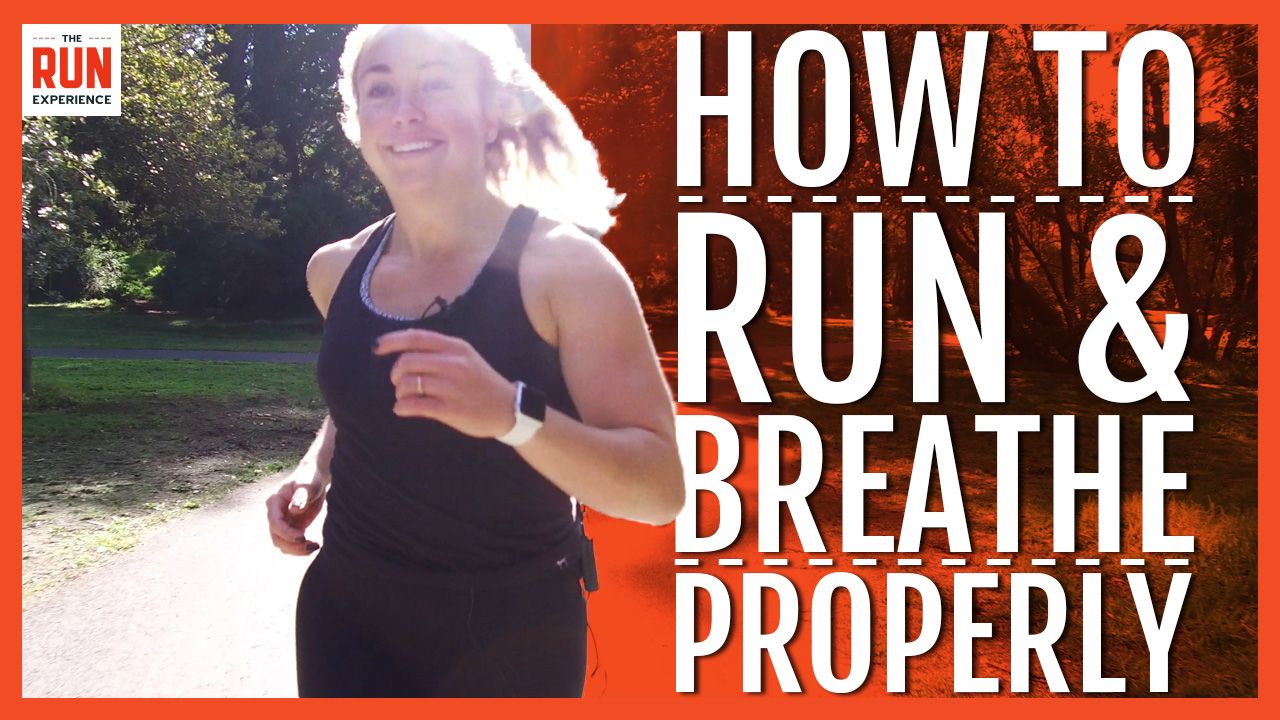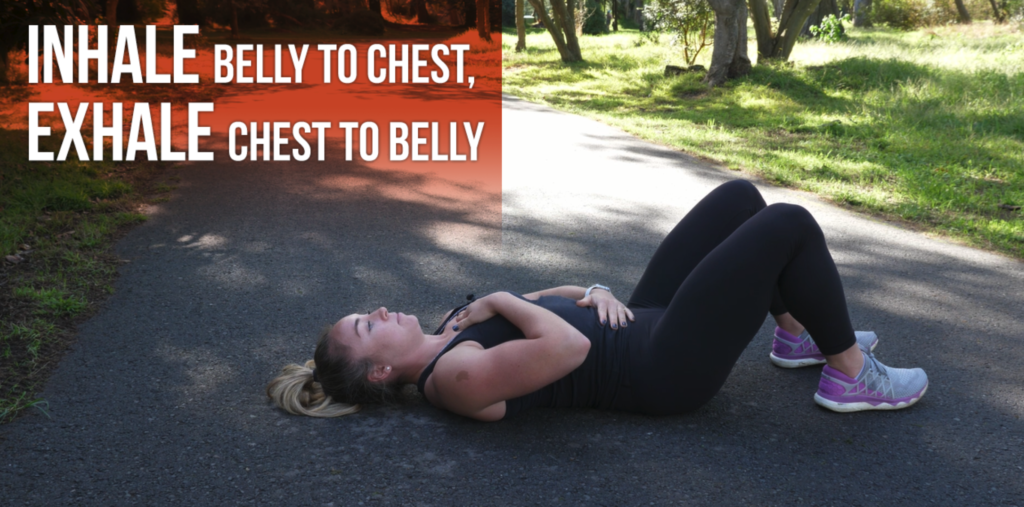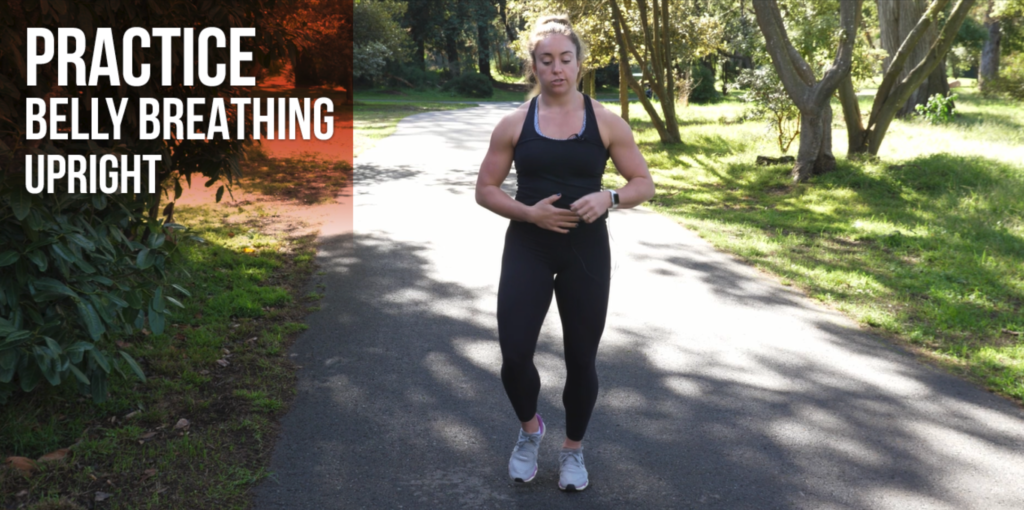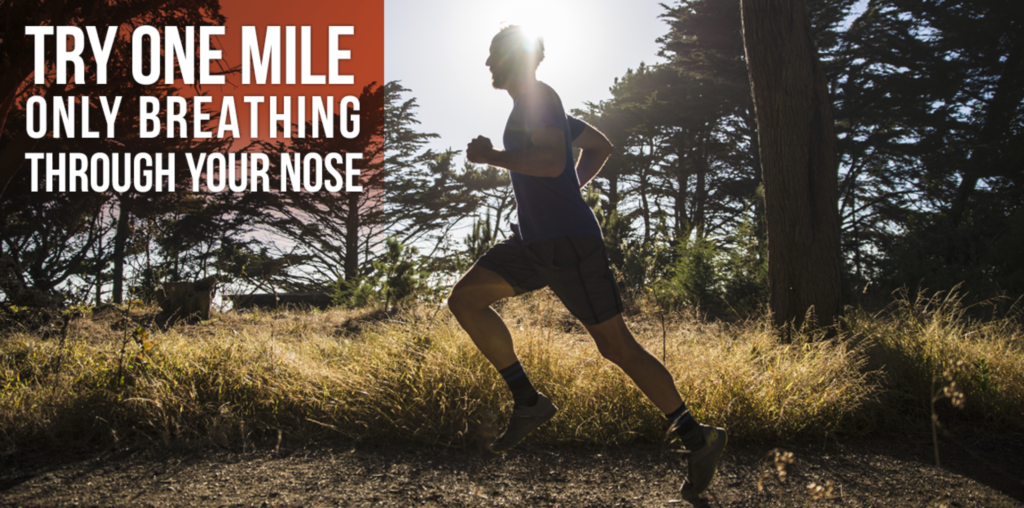How to Run Properly with Belly Breathing
Learn the art and science behind belly breathing, along with techniques for how to belly breathe while running (vs chest breathing).

Ask any runner how to run properly, and you’ll probably hear about heel strike, nutrition, or gear. These are what’s most often seen in magazines, videos, and running stores. Another factor to consider in your running is your breathing patterns and habits.
How is your breathing involved in running properly? Read on to learn more.
Breathing Mechanics and Running
Breathing is a default action that is easy to tune out. An inhale, an exhale, end of the story. However, understanding the difference between shallow chest breathing and deeper belly breathing is important.
Short, shallow chest breathing can compromise a runner’s full potential in performance, endurance, and even comfort. Most runners can recall a certain run where they felt out of breath for part of their mileage, likely a result of shallow breathing.
With some practice, any runner can take advantage of better breathing practices to help them run properly.
Belly Breathing
Belly breathing refers to using the diaphragm to help draw air into your body. The diaphragm is the large, stretchy muscle directly under your lungs. Engaging this muscle allows for greater expansion of your lungs and to inhale a larger amount of air.
When you take in fewer, larger breaths your breathing rate slows. A slower breathing rate can help you feel calm and comfortable under the stress of a run. Additionally, you’ll use less effort to maintain your breath throughout the run.
To get started with belly breathing, first get an idea of how you currently breathe.
Lay on the ground with one hand on your stomach and the other hand on your chest. At first, just see how your breath comes into your body — which hand moves first? Do they move at the same time? Does one not move at all?

Next, you’ll practice bringing your diaphragm into the mix. Inhale through your nose. Allow your belly to fill with air first, and then fill your chest. The hand on your belly should rise first, followed by the hand on your chest.
On the exhale, your chest will deflate first, followed by your belly. By having your hands on your stomach and chest, you’ll notice the pattern more easily.
How Belly Breathing Helps You Run Properly
Not only do you feel more comfortable with a bigger breath of air, you also bring in more oxygen with each inhale. That oxygen fills your lungs, where it comes into contact with your blood vessels. Those blood vessels carry the oxygen to the muscles all over your body, keeping you energized and able to run more comfortably.
It may feel weird to practice belly breathing while lying on the ground, but the purpose is to practice in a low-stress environment. Trying belly breathing for the first time while under the demands of a run can make it more difficult to really check in and feel the difference between chest and belly breathing.
As mentioned above, pulling your breath into your belly can help engage your core and get more oxygen into your bloodstream with each inhale. It can also help with your posture. Likely you’ve heard how important good posture and form are when it comes to running properly and efficiently.
The Benefit of Good Posture
Modern life tends to hunch us over. We slump at our desk, crouch over our phones, and recline on the sofa at home. We spend a lot of time with that forward lean, and this habit can be detrimental to your running.
Try hunching forward and taking in a deep belly breath. It’s difficult to expand your belly. Your diaphragm is compressed and there’s nowhere for it to go when you inhale. This will require more frequent breaths to keep your body oxygenated.
If you have this same posture on the run, your breath can only travel as deep as your chest. It won’t take long before you feel winded from the frequent shallow breaths. You may even decide to cut your run short because it’s stressful and uncomfortable.
Instead, use a deeper belly breath. The expansion of your diaphragm lungs will force you to stand up taller. This will create the posture necessary for the good breathing mechanics that will help you run properly.
Integrate Belly Breathing to Run Properly
Once you feel comfortable practicing your belly breathing on the ground, take it to the next level with some standing practice. You can either run in place or run in a flat, easy area like a park or on a bike path.

Again, start by placing your hand on your belly, and as you start to run (easy effort — think a level 3 or 4 out of 10), count how many steps you take while inhaling, and the same for exhaling. It will likely take you 3-4 steps for each inhale and exhale, but if it’s more or less, that’s what’s right for you. There’s no target number. The goal is simply to build some awareness of your breathing.
Just like when you were lying down, it might feel awkward or strange to breathe into your belly while running. It’ll take some practice to get comfortable with the process, but don’t rush. This isn’t a “one and done” improvement to your running. It’s a skill to revisit and practice regularly.
Your next progression will be to integrate this breathing awareness into your weekly long run. Choose to practice during an easy portion of the run when you aren’t pushing the pace or terrain. To practice, every 10 minutes spend 1 minute counting how many steps it takes for each inhale or exhale.
Most likely you’ll end up in that same range of 3-4 steps per inhale and exhale, but it may vary now that you’re not just running in place. Again, there’s no right answer here. You’re just building awareness of your breathing to help you run properly.
How to Belly Breathe
Incorporating belly breathing into your running can significantly enhance your performance, stamina, and overall running experience. By practicing and integrating this technique into all aspects of your running—from easy runs to competitive races—you ensure that your muscles receive optimal oxygen, your effort is managed effectively, and your mind remains calm and focused.
Here’s a guide on how to effectively incorporate belly breathing into your running routine.
1. Practice Belly Breathing at Rest
- Position: Begin by practicing while lying down, placing one hand on your chest and the other on your abdomen.
- Inhale: Breathe in slowly through your nose, ensuring your abdomen rises more significantly than your chest.
- Exhale: Release the breath through your mouth, feeling the abdomen lower.
- Goal: Develop awareness and control over your breathing pattern, ensuring the abdomen, not the chest, is the primary mover.
2. Integrate Belly Breathing into Your Running
- Start Slow: Begin with slow, easy runs, consciously applying the belly breathing technique.
- Inhale Deeply: Ensure your inhalations are deep and directed into the abdomen.
- Exhale Fully: Ensure exhalations are complete, expelling as much air as possible.
- Maintain Rhythm: Develop a consistent breathing rhythm, such as inhaling for three strides and exhaling for two strides.
- Goal: Make belly breathing a natural and automatic part of your running technique.
3. Utilize Belly Breathing to Manage Effort
- Monitor: Pay attention to your breathing rhythm in relation to your running intensity.
- Adjust: Use your breath as a guide to adjust your pace, ensuring it remains controlled and sustainable.
- Challenges: During intense efforts, like hill climbs or sprints, focus on maintaining efficient belly breathing to optimize performance.
- Goal: Use belly breathing as a tool to manage your effort and navigate various running intensities effectively.
4. Apply Belly Breathing in Races and Workouts
- Preparation: Prior to races or intense workouts, engage in a few minutes of focused belly breathing to calm the mind and prepare the body.
- During the Event: Ensure your breathing remains deep and rhythmic throughout the event, using it to manage your effort and stay focused.
- Recovery: Post-event, continue to utilize belly breathing to facilitate recovery and return to a state of calm.
- Goal: Leverage belly breathing to enhance performance, focus, and recovery during races and high-intensity workouts.
5. Address Challenges and Refine the Technique
- Challenges: If you find belly breathing difficult during certain phases of your run, revert back to practice sessions at rest or during easy runs.
- Refinement: Continuously refine the technique, ensuring it feels natural and beneficial.
- Seek Guidance: If challenges persist, consider seeking guidance from a coach or attending a breathing workshop.
- Goal: Ensure belly breathing becomes a seamless and advantageous component of your running technique.
Belly Breathing vs. Chest Breathing
Not sure of the difference between belly breathing vs. chest breathing? Let's cover the nuances and their implications.
Belly Breathing (Diaphragmatic Breathing)
Involves deep inhalations through the nose, causing the diaphragm to expand and the abdomen to rise, followed by full exhalations, typically through the mouth. It can be difficult to master initially, especially during high-intensity activities. However, it's recommended for endurance running to optimize oxygen utilization and maintain a relaxed state.
Benefits:
- Maximized Oxygen Uptake: Facilitates optimal oxygen intake and carbon dioxide expulsion, enhancing muscle performance.
- Reduced Stress: Promotes a calm and focused mental state by activating the parasympathetic nervous system.
- Enhanced Stamina: May improve endurance by ensuring efficient oxygen delivery to muscles.
Chest Breathing (Thoracic Breathing)
Involves shallower, quicker breaths, primarily expanding the chest and utilizing the intercostal muscles. May not provide as efficient oxygen delivery to muscles during sustained activities and can potentially induce a stress response by activating the sympathetic nervous system. It may be instinctively utilized during sprinting or high-intensity intervals but is generally not recommended for sustained endurance running.
Benefits:
- Quick Oxygen Intake: Allows for rapid oxygen intake and expulsion, which can be useful in short, intense bursts of activity.
- Instinctive Response: Often a natural response to high-stress or high-intensity situations, providing quick oxygenation.
Comparing the Two Breathing Techniques
- Efficiency: Belly breathing is often deemed more efficient for sustained activities due to enhanced oxygen uptake, while chest breathing may be instinctively utilized during short, intense bursts.
- Stress Management: Belly breathing is associated with a relaxed, focused state, while chest breathing may induce or correlate with a stress response.
- Endurance vs. Sprinting: Belly breathing is typically recommended for endurance running, while chest breathing might be observed during sprinting or high-intensity efforts.
- Learning Curve: Belly breathing may require conscious practice and integration, while chest breathing is often an instinctive response to increased demand.
Nose Breathing Mile Challenge
For this next step, you’ll be practicing your belly breathing by inhaling and exhaling exclusively through the nose. This is like leveling up your running, as you’ll be forced to stand up tall, take deep breaths, and control your effort throughout the run.

You can do this as a stand-alone run, or integrate it into one of your regular runs.
- For 1 mile, you’ll breathe exclusively through your nose.
- Experiment to find a pace that isn’t too fast or intense.
- Regression: If this is a struggle, practice inhaling through your nose, and exhaling through your mouth.
- Progression: To keep it challenging, sprinkle these mile-long efforts throughout your run for further practice.
The result? Controlled breathing, strengthened diaphragm engagement, and better posture, and a lot of energy! Not bad, right?
